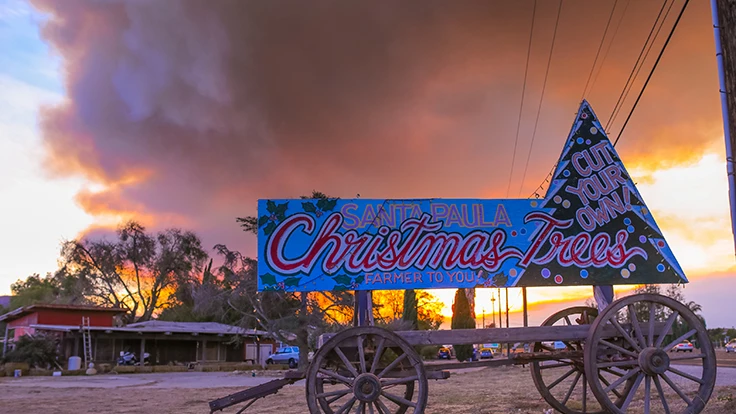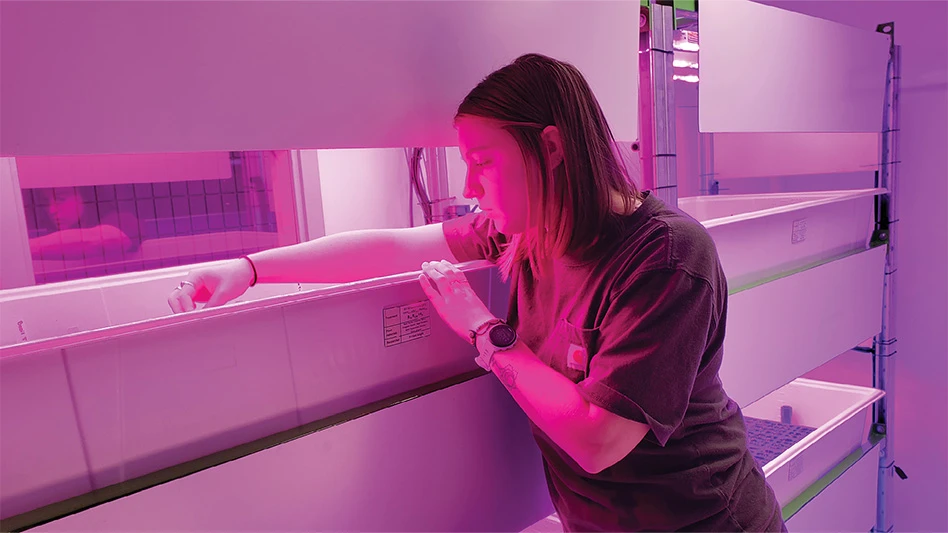
In the first week of December, Gov. Jerry Brown of California declared a state of emergency after wildfires broke out and destroyed roughly 800 structures in the areas of Ventura, Oceanside and Ojai.
Brown later claimed the recent spate of wildfires in his state is the “new normal” for Californians, according to the L.A. Times.
For hundreds of residents and businesses in the affected regions, including several independent garden centers, life feels anything but normal. The series of blazes that originated near Ventura on Dec. 4, officially designated the Thomas Fire, have burned down entire neighborhoods and dramatically worsened air quality in neighboring communities.
“A lot of our neighbors have left their homes,” says Faye Johnston, manager of Flora Gardens in Ojai. “The evacuations in this immediate area have ended. The evacuations have changed and they’re more north, now, as the fire moves northwest. So now, we’re primarily dealing with air quality issues. Everyone’s wearing a mask. It’s apocalyptic here.”
Flora Gardens’ retail building, located in a mostly rural area, has not yet been directly damaged by the fires, but many customers and neighbors have lost their homes.
“We were closed all last week, and we just reopened [Dec. 11] minimally. People are just coming in for community,” Johnston says. “They’re coming in for a Christmas wreath because they need some kind of cheer or they’re bringing it to donate to someone who’s lost their home, but people just come in because it’s a community spot. So, they’re coming in just to see us, say ‘hi’ and check in. It’s just an intense, surreal time. It’s heavy.”
The original cause of the Thomas Fire is still being investigated, according to an incident report from the Cal Fire website. As the wildfire spread, evacuation centers were established in the cities of Ventura, Oxnard and Goleta. The report listed an early fire damage estimate of $48.6 million. Buildings have also been lost in Montecito, according to local news affiliate KSBY 6.
Unprecedented danger
On Dec. 14, authorities reported the first firefighter casualty of the Thomas Fire – Cory Iverson, who had been with Cal Fire for eight years, died while battling the blazes.
Emergency organizations have worked through the dire circumstances and made tragic sacrifices to contain the historic fires. Meanwhile, businesses and residents in the vicinity are coping with the worsened air conditions and remaining vigilant in case evacuation becomes necessary.
Mike Tully, owner of Terra Sol Garden Center in Santa Barbara, says that there’s only so much a green retailer can do to prevent damage from a wildfire incident.
“We really can’t prepare here,” he says. “The majority of our grounds are exposed to the open air, we have our little houseplant and greenhouse area and some covered breezeways, but we really can’t do anything to prepare for it, unfortunately. We’ve been reducing our hours because there’s no traffic flow, and I’m basically letting every one of my crew members know, ‘you are not required to work. It’s your choice.’”
Although Ventura has suffered hundreds of damaged or destroyed buildings, the spreading Thomas Fire has not yet significantly threatened major portions of Santa Barbara, thanks to containment efforts by fire response personnel.
“I’d say the actual flames burning, from our store, are probably 8 to 10 miles away, so we’re not concerned here at his point, as far as fire coming this far over,” Tully says. “[Firefighters] are letting a huge amount of brush burn. There’s stuff that hasn’t burned for 30 to 60 years in these zones that are burning now. They’re letting the majority of the fuel out there burn and just making stands at main roads, where they feel they can defend best.”
Direct fire damage may not currently be a concern for Terra Sol Garden Center and other businesses outside the actively burning areas, but business activity has nonetheless been significantly stunted due to ongoing evacuations and road closures.
“I think it’s somewhat fortunate it’s not a super high traffic time of year for us, as far as our business goes, but I’d say my business is down probably more than 50 or 60 percent from what we would normally be doing,” Tully says. “You’re seeing that most of the shopping is extremely need-driven, no looky-loos or browsing going on all throughout retail in Santa Barbara.”
Retailers aren't the only green industry businesses impacted by the fires. Many growers and breeders have facilities in Central California, including PanAmerican Seed, which operates a seed facility in Santa Paula.
“Our facility in Santa Paula appears to be out of fire danger at this point as the fires have moved north. All of our employees are back in their homes and no one experienced any damage to their home or property. We are experiencing ash coming down on the greenhouse,” says PanAmerican Seed President Anne Leventry. “However, the fire is still quite a distance south from our additional facility in Guadalupe, and we remain hopeful that we will not experience any damage to any of our locations as a result of this fire. We are very thankful to all the brave and hardworking firefighters who have really fought these severe fires and saved so many people and structures.”
Fighting for normalcy
In addition to lost business, people living and working in and around Ventura and Ojai are having to adjust to major disruptions to daily life, including smoke warnings, water quality issues and more.
“Most of the power is back in most locations – we were without power [for the first week of December]. You can’t drink the water, you have to boil the water. And masks are advised,” Johnston says. “Other than that, you’re not supposed to use water for watering, but there’s nothing to water, anyway. In some evacuation zones, the mandatory evacs have been lifted, and they’re adding other areas as [the fire] climbs up the coast. It’s changing. It’ll be a long time before things are back to normal.”
In the wake of Governor Brown’s “new normal” statement, many Californians are looking ahead to what the Thomas Fire means for the future of living and working in the Golden State – especially for people in the business of growing and selling plants.
“It’s a bigger issue,” Johnston says. “There’s the small issue and then the bigger issue – like, climate change and why this is all happening and how and what’s in store for us. We just need to re-evaluate how we do things and how we live and plan. I think it’s just a big eye-opener.”
Photo courtesy of Dreamstime.
Latest from Greenhouse Management
- CEA Alliance celebrates bipartisan introduction of Supporting Innovation in Agriculture Act
- Dümmen Orange North America celebrating 25th anniversary in 2025
- CEA HERB Part 1: Best management practices for culinary herbs
- Lawsuit challenges new H-2 visa rules
- CEA HERB Part 2: A guide to increasing the sowing density of culinary herbs
- Illinois Landscape Contractors Association changes name to Landscape Illinois
- 2025 Proven Winners Horticulture Scholarship applications now open
- ICL’s Gemini Granular herbicide now registered for use in California







